Banana is a fruit of the Musaceae family and is one of the world’s most important fruit crops. Banana is the most common and profitable fruit. Bananas are one of the most enjoyed fruits in the United States. Bananas are so cheap and widely available that decades ago, they overtook apples to become the most consumed fruit in the country. Bananas are considered berries and grow in clusters hanging from the plant.
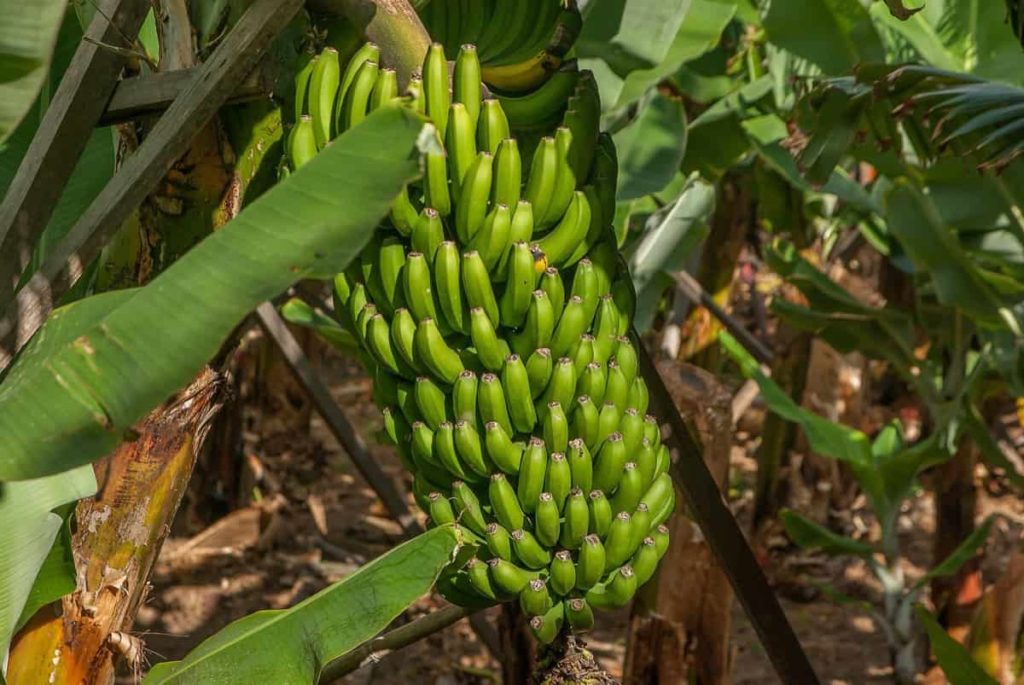
Bananas grow best in warm, humid climates and are imported from Central America, including Panama, Costa Rica, Guatemala, and Ecuador. Banana fruits come in all different colors, sizes, firmness, and taste. There are over 1,000 different types of Bananas, about half of which are inedible. Let’s check out more information on how to start banana farming in the USA below.
How to start Banana farming in the USA
Banana varieties available in the USA
Cavendish Bananas – These Bananas are the most common type, readily available in supermarkets in the United States. They are available from young green to fully ripe, from smooth yellow to deep yellow with brown spots when ripe. You can add them to smoothies, pancakes, or Banana bread.
Cavendish Bananas are the most common variety. These are the long yellow, slightly sweet Bananas in supermarkets around the US that range from underripe green to perfectly ripe and still firm mellow yellow to deep yellow, very soft and brown when ripe with one or two brown spots. The perfect ripeness depends on personal taste. They are grown throughout Central America, and their production is essential to the economies of these regions.
Apple Bananas – Apple Bananas are exceptionally sweet, hence their other name, Candy Apple Bananas. They are grown in the tropical rainforests of Hawaii. Their flesh is firm and has a slight pink tone. It is perfect for snacking or using in desserts. It is especially suitable for adding to fruit salads and other raw preparations because it doesn’t brown as quickly as other Banana varieties.
Macho Plantain – Macho plantain is common in Florida. It is the popular Banana variety grown in the United States. This variety has a deep sweet and sour flavor, making it perfect for sautéing in butter, roasting, or grilling.
Manzano Banana – The Manzano Banana is sweeter than the Cavendish Banana with a hint of crunchy apple strawberry flavor. They are grown in Central and South America, the Caribbean, and Mexico. They are small and plump with thoughtful yellow skins that turn black when fully ripe.
Plantain – Plantains are a subgroup of Bananas known as cooking Bananas. They are high in starch and are commonly used in savory dishes. They are not usually eaten raw. They are a staple food in West and Central Africa, the Caribbean Islands, and Central America.
Are there Banana farms in the US?
The largest Banana producer in the USA is Hawaii, followed by Florida. Banana production in Hawaii is approximately 8,090 MMT to 13,181 MMT.
In case you missed it: A Step-By-Step Guide to High Density Fruit Farming: For Guava, Banana, Mango, Pineapple, Lemon, Papaya, Litchi, and Apple
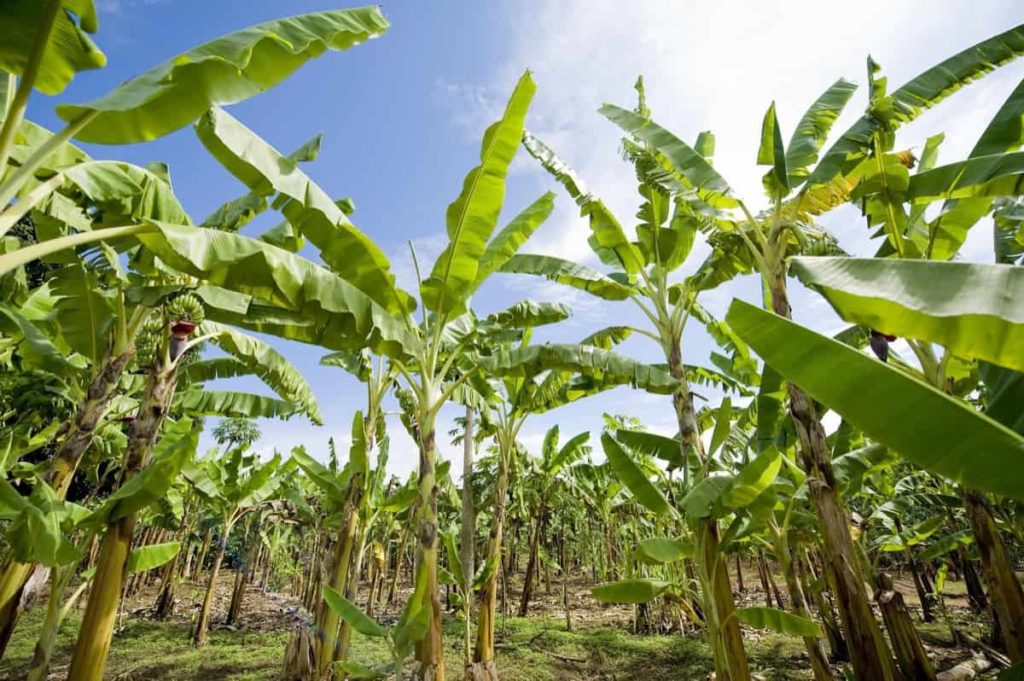
Suitable soil for Banana farming in the USA
Bananas do best on flat (slope 0-1%), well-drained, deep organic matter soils with a pH of 5.5–7. Banana varieties perform well in sandy, muck, loamy, and calcareous marl and rocky soils mainly found in South Florida. The most important factor is soil drainage.
In areas susceptible to wet or flooded soil conditions, sufficiently high beds or mounds should be created, and the land should be properly engineered (sloped) for drainage. The beds will keep most of the root system above the saturated soil layer, and the proper slope of the pits between the beds allows excess water to drain from the ground.
The best location for Banana farming in the USA
The USA is the largest consumer of Bananas; the only real locale for them would be Florida and Hawaii. The largest Banana producer in the USA is Hawaii. The tropical island grows the popular Cavendish Banana variety while producing the local favorite Hawaiian Apple Banana. Florida is another state that does commercial Banana production but on a much smaller scale than the Aloha State.
Florida prides itself as the largest exporter of Bananas in the United States. The Sunshine State produces Thai and Bluggoe (cooking) Banana varieties. Banana is most notable in Texas, Louisiana, California, Arizona, Mississippi, Georgia, Alabama, South Carolina, and coastal North Carolina (outside of Florida and Hawaii). In Hawaii, yields of 12,000, 15,000, and 35,000 lb/acre can typically be achieved respectably for ‘Brazilian,’ ‘Bluefields,’ and ‘Cavendish.’ Yields of 75,000 lb/acre have been reported under optimal conditions.
In improved plants in Central and South America, yields can exceed 40,000 lb/acre. Banana plants grow rapidly and usually reach 20-40 feet in about 9 months. As they prepare for harvest, pickers need to look for tarantulas. A Banana plant can produce up to 240 Bananas; once they are picked, it doesn’t take long for new Bananas to appear.
Commercial Banana production in the USA
Commercial Bananas are grown on only 16,000 acres in the United States. That’s a very small area – less than 0.01% of the total land in the United States. Banana cultivation in Hawaii has followed an increasing trend from 13,181 MMT to 8,090 MMT. Hawaii primarily produces Bananas of the traditional Cavendish classification and Hawaiian apples, which are sold in local markets because of high employment and land.
The largest exporter of US Bananas is Florida, which produces most of the Thai and cooking Bananas (Bluggoe variety). Also, US Banana producers are looking for opportunities in the organic segments of the Banana market in Florida, California, Mississippi, Texas, Alabama, South Carolina, and Georgia. Bananas in Florida are about 500 acres valued at the US $2 million.
In case you missed it: Top 20 Steps to Boost Your Banana Fruit Yield: How to Increase Fruit Size, and Production
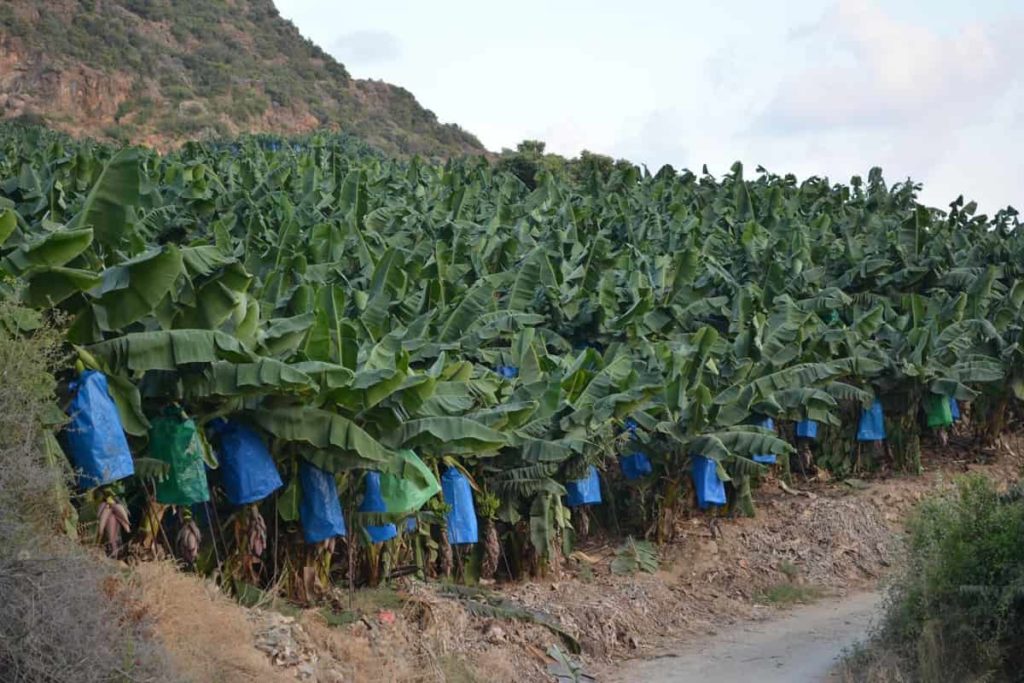
Other states in the USA that remain popular locations for independent Banana farming, typically only exported at a domestic level, are Georgia, Louisiana, Mississippi, Arkansas, Texas, Oklahoma, Alabama, South Carolina, North Carolina, Virginia, Arizona, and California. These states produce a variety of varieties depending on the region, including the Cavendish, Bluggoe, Lady Finger, Red Dacca, Ice Cream, Goldfinger, Latundan, Pisano Awak, and Balbisinia subtypes.
Banana farming in the United States is diverse, with some areas of the country maintaining plantations of a wide variety of Banana trees as perennial or near-perennial planting systems. It is most notable in Texas, Louisiana, California, Arizona, Mississippi, Georgia, Alabama, South Carolina, and coastal North Carolina (outside of Florida and Hawaii).
Other regions of the country (northern Arkansas, southern Missouri, mountain Tennessee, southern Kansas, the far southern Midwest, and along the Ohio River, Kentucky, and Virginia) have a climate similar to the Banana-growing region of the inland South. Banana cultivation is mainly in central and eastern China (Sichuan, Anhui, Zhejiang, Hubei, Jiangsu, Henan, Jiangxi, Hunan, Chongqing, and Guangzhou provinces) and is more seasonal. Also, Banana plants are grown commercially in Puerto Rico, Guam, and American Samoa.
Can Bananas grow in Texas?
Trees will produce heavy fruit in frost-free areas. Banana fruits can be grown in most parts of Texas. These plants are tropical so they will grow well in Texas. Fruit production is favorable in warmer regions, and trees are used as ornamental specimens in cooler regions.
Why are most US Bananas grown in Florida and Hawaii?
Bananas grow best in tropical climates. Where the temperature is hot, and the air is humid. In humid climates, they grow rapidly and produce large fruits. It means farmers get more Bananas for the same amount of effort. So, if a person or company wants to grow Bananas on a commercial scale, they will select a tropical region because they will earn more profit.
Both the states of Hawaii and Florida have a tropical climate. Texas, California, and Arizona get hot and can sometimes be humid. But by and large, it is a very dry heat which is not suitable for growing Bananas. Other states across the US are hot in the summer but cool in the winter. And as a result, you can’t grow them year-round like you can in Florida and Hawaii.
Can Bananas grow in Florida?
Bananas will do best when planted in moist, fertile soil in a sheltered location with full sun. Because most Florida soils are sandy and have low fertility, Bananas require frequent fertilization (4 to 6 times a year) for high growth and yield rates.
Tips for Bananas growing in California
Bananas can be grown successfully here in Southern California if they are provided with the right soil conditions and protected from below-freezing temperatures.
Can you grow Bananas in San Francisco?
Edible Bananas usually grow in areas between 30 degrees south latitude and 30 degrees north latitude. For example, California, San Francisco, is at 37 degrees north latitude, San Diego is at 32 degrees north latitude, and Miami, Florida, is at 28 degrees north latitude.
Best climate and site for growing Banana in the USA
- Bananas grow best in the humid tropics. In the USA, Bananas can be grown in USDA zones 9 through 11. Some crops can survive with protection in colder zones, as cold as zone 5.
- Banana trees grow best in full sun, but when high temperatures, the leaves, and fruit can become sunburned and scorched in the high sun. Check the growing conditions of the variety you choose to grow.
- In some locations, some Banana varieties are best planted in partial shade—planting Bananas in fertile, loamy, well-drained soil.
- Bananas prefer a soil pH between 5.5-7.0.
- Protect Banana trees from wind for maximum crop yield. Banana trees are susceptible to wind damage; they can be dislodged and blown away by the wind.
- Bananas are best planted in a block or clump of several plants. Block planting allows shallow-rooted plants to support each other. Block planting also increases humidity around the plants. Plants in centers or blocks produce the best fruit because they are sheltered from the wind. A block can have 5 rows of 5 plants in each row; each plant is about 5 feet apart.
In case you missed it: Top Varieties of Bananas in India: Best List, Banan Types for Higher Profits, and Yield
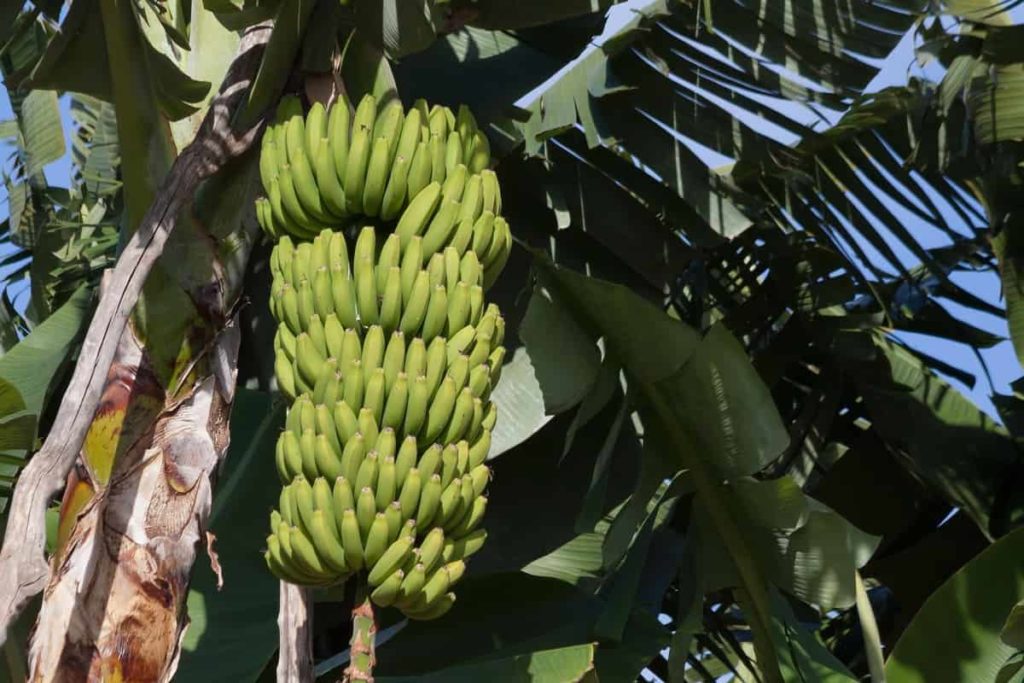
Planting Banana Trees in the USA
Place Banana trees in an area with at least six hours of sunlight daily. If Banana trees are kept inside, place them near a sunny window. They are also sensitive to wind, so make sure you place them near a wall or behind a row of evergreens. Additionally, Banana trees prefer slightly acidic soil. Make sure you can test the soil pH level with a kit from your local gardening store. Increase the soil acidity by adding peat moss or a high-nitrogen fertilizer.
In terms of soil, keep the soil moist but not oversaturated. You can also increase the soil drainage by adding organic material such as peat moss. Bananas are grown from root divisions or cuttings. A portion of the root is cut from the mother plant and replanted. The division may or may not include the growth of leaves, called suckers. It is best to use root division with leaf growth.
Choose a sucker from a strong Banana plant and choose a sucker that has small and spear-shaped leaves. A 3- or 4-foot-long sucker is best. Small suckers take longer to fruit, and the first bunch of Bananas will be smaller. Cut the suckers from the main Banana plant with a sharp blade. Cut downward between the mature plant and the sucker. Cut the sucker with a pruning knife or saw if a spade isn’t sharp enough.
Roots should be included in the sucker. Replant the division, so the plant roots are covered at about the same level they were growing with the mother plant. If you plant root divisions without leaves, keep the division 1 to 2 inches below the ground.
Banana tree care
- Although most species grow best in warm climates, some cold hardy Banana trees exist. Choosing the right planting spot is key to making maintenance easy if you’re planting a Banana tree outdoors.
- Grow this plant in a location protected from strong winds, as it is susceptible to damaged leaves. Prepare your planting spot by adding some compost to the soil. And, remember you have enough space for the height and spread of your particular species.
- During the growing season, spring to fall, Banana trees are water hogs. You may need to water daily, especially in hot weather, to maintain adequate soil moisture. Plants will also need regular fertilization during the growing season. Bananas form in late summer in clusters called hands. Once the fruit is green but plumped up, the stalk can be cut off and stored in a cool, dry place to ripen.
In case you missed it: Dwarf Banana Farming -Plantation In India
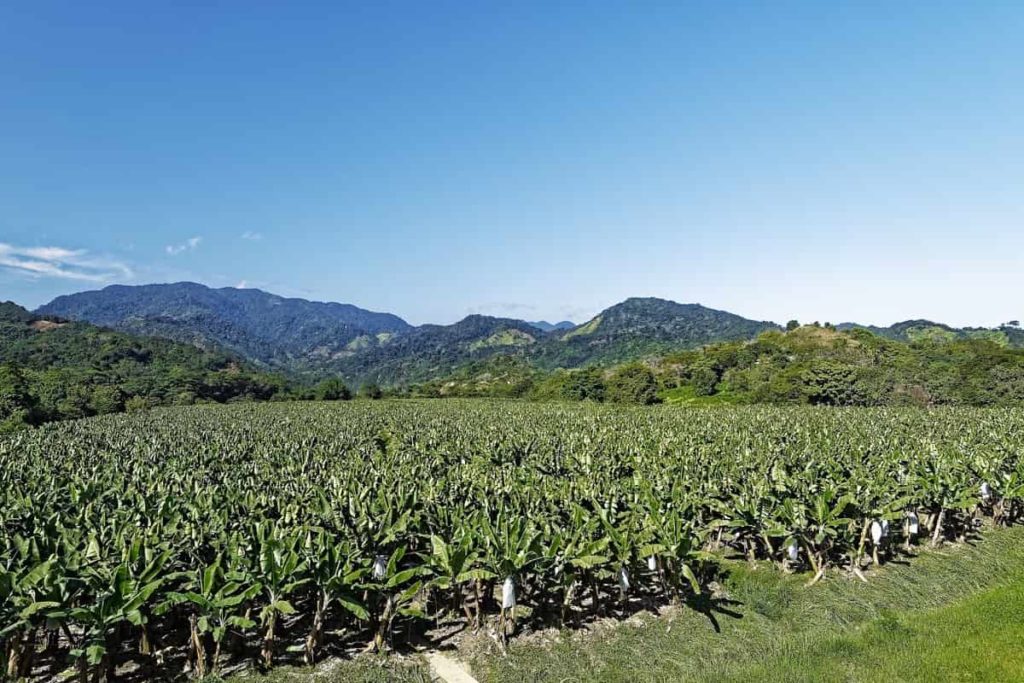
Irrigation management
Banana trees are tropical and grow in rainforests, so they need a lot of water and moisture in the air. They do best when planted in groups close together, as this helps retain moisture in the leaves. Water regularly to ensure the soil is evenly moist but not soggy. Avoid overwatering the plant, which can cause root rot.
Banana Farming Importance in the USA
1. Harvesting is easy – Bananas grow in one bunch on one main stem. So, when they’re ready, growers cut out the main stem with a swipe of a knife, and then they can take all the Bananas at once. Compared to other fruits, you have to pick them one by one; they take very little time to harvest. Therefore, Banana farmers do not have to spend much on labor costs.
2. Easy to transport – Bananas grow in bunches and don’t get damaged when you stack them on top. They can also be ripened upon arrival. Bananas are very hard when they are still green, and don’t bruise them when you stack them on top of each other. Also, they can be green when harvested and ripen over time. It means they will hold up well even during long transport times.
3. They grow year-round – Banana plants produce one or two main Banana stems. Several bunches of Bananas grow on each stem. But, after your producers harvest the Bananas, the next Banana stems are not as big and don’t produce as many Bananas. So, farmers cut down the Banana plant once they removed all its stems.
When they cut down a Banana plant, another Banana plant grows in its place. When they cut it, a new shoot grows from the left stump, regardless of the time of year. It means farmers have a continuous harvest and can keep prices low regardless of the season.
US market for fresh Bananas
Unlike the EU, the US Banana market is free from tariffs or quantitative import restrictions, making it a competitive market. Bananas are still the largest fresh fruit imported into the United States by value or volume. Guatemala is the largest supplier of fresh Bananas to the United States. The USA has become an important market for Guatemalan Bananas, accounting for 85-90 percent of total Banana exports.
Ecuador maintains its position as the second-largest supplier of fresh Bananas to the United States, with a market share of 24 percent. The main conventional Banana brands in the United States are Dole, Chiquita, Del Monte, Turbana (Uniban), and Bonita (Exportadora Nobua). It helps limit the plant to three or four stalks of different ages for good fruit production. Must be the oldest and longest flowering and fruiting.
The second should be one-half to one-third the size of the first. And finally, there should be one or two young Banana plants that are six to three feet tall. Bananas in South Florida should also be watched for signs of nematode damage or signs of Fusarium wilt and Sigatoka disease.
In case you missed it: Red Banana Farming, Cultivation, Planting Methods
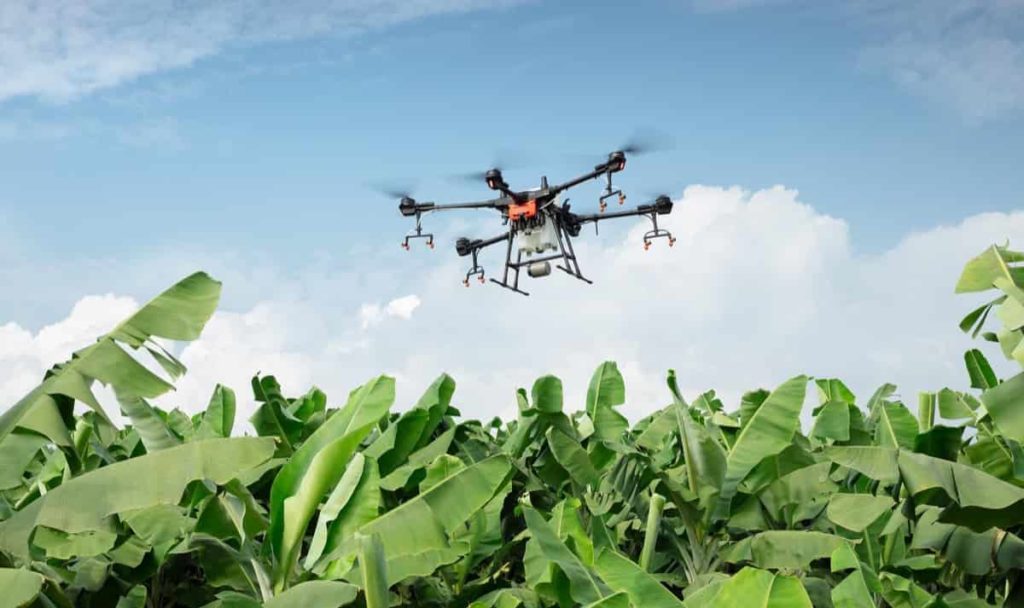
The harvesting season for Banana farming
Bananas are usually ready for harvest in late spring or early summer. The best time to pick your Bananas is when the fruit is still green. After harvesting the Banana, cut your tree back to about 30 inches and allow the trunk to dry for two weeks before removing it. Dwarf Bananas are ready for harvest 11 to 14 months after planting, while tall cultivars take 14-16 months to harvest.
Depending on climate and cultural practices, it usually takes 90-120 days for a bunch to mature after shooting. Banana maturity is indicated by drying the upper leaves, the color of the fruit changing from dark green to light green color, and the tendency of the flower tip of the fruit to fall off when lightly touched by the hand.
Conclusion
Bananas grown in the United States are mostly grown in Florida and Hawaii. The reason is that both these climates are tropical. Bananas grow large and fast in tropical climates. So, many commercial Bananas are grown there because of the companies that make the most money. Commercial Banana farming in the USA is relatively limited in scale and economic impact.
While Americans eat about 26 pounds (12 kg) of Bananas per person each year, most of the Banana fruit is imported from other countries, particularly Central and South America, where the United States previously occupied Banana plantation areas, and Its import is controlled. Bananas by various fruit companies, such as Dole and Chiquita.
- How to Make Houseplants Bushy: Effective Tips and Ideas
- Innovative Strategies for Boosting Coconut Pollination and Yield
- Pollination Strategies for Maximum Pumpkin Yield
- The Complete Guide to Chicken Fattening: Strategies for Maximum Growth
- Natural Solutions for Tulip Problems: 100% Effective Remedies for Leaf and Bulb-Related Issues
- Revolutionizing Citrus Preservation: Towards a Healthier, Greener Future
- Natural Solutions for Peony Leaf and Flower Problems: 100% Effective Remedies
- Maximizing Profits with Avocado Contract Farming in India: A Comprehensive Guide
- Natural Solutions for Hydrangea Problems: 100% Effective Remedies for Leaf and Flowers
- The Ultimate Guide to Choosing the Perfect Foliage Friend: Bringing Life Indoors
- From Sunlight to Sustainability: 15 Ways to Use Solar Technology in Agriculture
- The Ultimate Guide to Dong Tao Chicken: Exploring from History to Raising
- The Eco-Friendly Makeover: How to Convert Your Unused Swimming Pool into a Fish Pond
- Mastering the Art of Delaware Chicken Farming: Essentials for Healthy Backyard Flocks
- 20 Best Homemade Fertilizers for Money Plant: DIY Recipes and Application Methods
- How to Craft a Comprehensive Free-Range Chicken Farming Business Plan
- Brighten Your Flock: Raising Easter Egger Chickens for Beauty and Bounty
- How to Optimize Your Poultry Egg Farm Business Plan with These Strategies
- Subsidy for Spirulina Cultivation: How Indian Government Schemes Encouraging Spirulina Farmers
- Ultimate Guide to Raising Dominique Chickens: Breeding, Feeding, Egg-Production, and Care
- Mastering the Art of Raising Jersey Giant Chickens: Care, Feeding, and More
- Ultimate Guide to Raising Legbar Chickens: Breeding, Farming Practices, Diet, Egg-Production
- How to Raise Welsummer Chickens: A Comprehensive Guide for Beginners
- How to Protect Indoor Plants in Winter: A Comprehensive Guide
- Ultimate Guide to Grow Bag Gardening: Tips, Tricks, and Planting Ideas for Urban Gardeners
- Guide to Lotus Cultivation: How to Propagate, Plant, Grow, Care, Cost, and Profit
- Agriculture Drone Subsidy Scheme: Government Kisan Subsidy, License, and How to Apply Online
- Ultimate Guide to Raising Araucana Chickens: Breed Profile, Farming Economics, Diet, and Care
- Bringing Hydroponics to Classroom: Importance, Benefits of Learning for School Students
- Ultimate Guide to Raising Polish Chickens: Breed Profile, Farming Economics, Diet, and Care
- Ultimate Guide to Raising Australorp Chickens: Profile, Farming Economics, Egg Production, Diet, and Care
- Silkie Chicken Farming: Raising Practices, Varieties, Egg Production, Diet, and Care
- Sussex Chicken Farming: Raising Practices, Varieties, Egg Production, Diet and Care
- Homemade Feed Formulations for Livestock: Discover Cost-effective Starter to Finisher Feed Recipes
- 20 Best Pig Weight Gain Supplements: Top Swine Weight Gain Formulas
- Ultimate Guide to Elderberry Farming: Propagation, Planting, Yield, Cost, and Profit